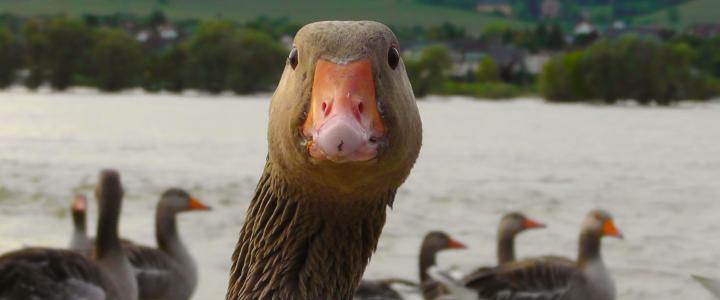
April 2022: Duck ... Duck ... Don't Feed the Goose!
Canada Geese are a common sight around lakes and ponds in New Hampshire, which makes sense: Their natural habitats are along a waterbody’s bank or shore. If left to nature, their presence would be a nice addition to the landscape, enjoyable for wildlife enthusiasts, avid bird watchers and curious children (especially if they are just making a pit stop during their migration). But too often, these goose populations grow into major nuisances that can do very real damage to the surrounding environment.
One of the biggest causes of goose overpopulation is people feeding the geese and other waterfowl. Areas known for handouts will see a few geese increase to 100-fold over time. This seemingly generous act is actually harmful to both the animals and the waterbodies they populate. Most foods people like to give to geese and other waterfowl – bread and crackers – are harmful to them, because they tend to fill up on that instead of regular nutritional sources, according to the New York Department of Environmental Conservation. The geese actually have plenty of natural food sources, such as aquatic plants and invertebrates, to fill up on.
Aside from the health of the animals, the health of the lakes and ponds can be severely affected by goose overpopulation:
- First, uneaten bread is unsightly, and it can rot and release noxious odors. In addition, rotting bread can attract pests, such as rats, mice and insects.
- Excess nutrients can be caused by an unnatural number of waterfowl droppings. Geese defecate both on land and in the lake and the droppings are high in organic matter and nutrients. These are the same nutrients that accelerate aquatic plant growth and algal blooms.
- Overpopulation can also lead to drastically increased levels of E. coli, a bacteria found in the geese droppings that in high numbers in water can cause gastrointestinal problems for people swimming in it. You should avoid contact and ingestion of water in areas frequented by geese.
- Another problem for swimmers is the potential for swimmer’s itch. Swimmer's itch, an allergic reaction to a parasite of birds and mammals, is commonly found in areas with high numbers of geese.
- Vegetation around the immediate feeding site is also impacted because the overabundant population will trample the grass and damage the plants. Overpopulation can also lead to overgrazing and degradation of natural areas.
While you may think that you are helping geese by feeding them, you can be hurting them and polluting the environment. Wild geese have plenty of healthy food in their habitat. Let them find food on their own so that they and other animals in the environment can stay healthy.
There are more ways to prevent a nuisance goose population or work to control one that is already out-of-hand. Read our fact sheet on Canada Geese Facts and Management Options for more information.




